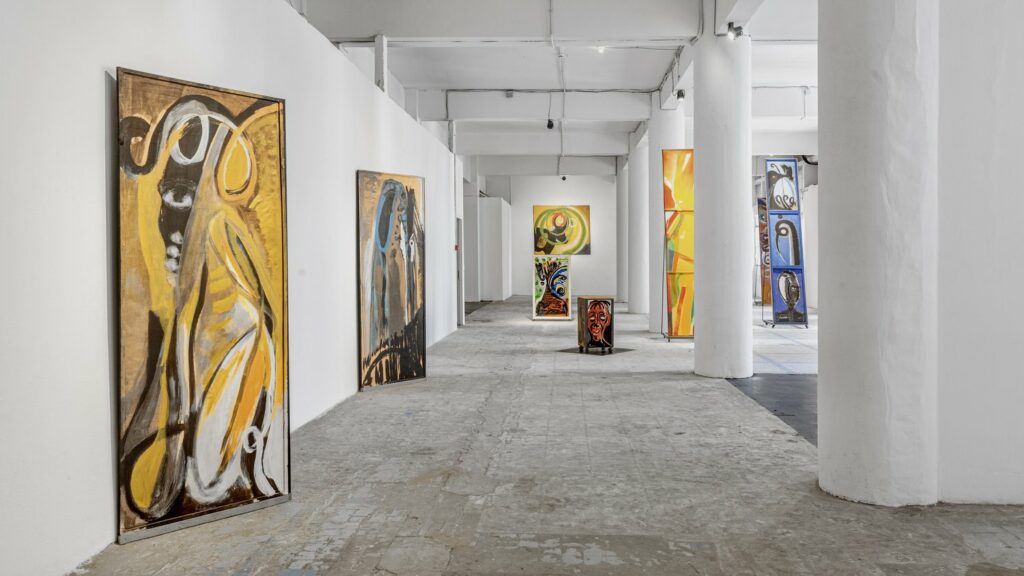Selebe Yoon, Dakar, Senegal
19 May 2022 - 30 Jul 2022

© Selebe Yoon
The title of the exhibition Now / Naaw plays on the simultaneous Wolof meaning of the word “to fly”. As a painter, El Hadji Sy works are made with a variety of materials such as industrial jute sacks originally used to ship rice or sugar, kites, butcher’s paper and recycled paper, mirrors, glass, shells, wood, tar – and all hold a performative function. Mobile like props on a stage, semi-functional, blurring the boundaries between functionality and aesthetics, his works metamorphose into paravents, doors, windows, clothes, furnitures and itinerant structures.
His political stand manifests itself with paintings both figurative and abstract that convey a visual musicality whereby the bodies and forms submit themselves to a permanent undulatory rhythm. From poetic interpretations of political events, renderings of daily scenes, references to Dakar’s urbanism, portraits of political, intellectual, mythological or ordinary figures, his works interweave politico-socio economical comments and critical reflections on cultural and globalized systems of production.
In “Now / Naaw”, his new works conceived as assemblages of panels and columns on wheels with a variable compositional scheme transform the exhibition venue into a heterogenous landscape. El Hadji Sy disobeys the “don’t-touch” institutional rule of museums that sanctifies the artwork and imposes a distant and contemplative relationship to the visitor. In his exhibition, the artist-scenographer subverts the space, imposes a choreography to the visitor who must work around, touch, walk through, open or close the piece in order to have access.
Naaw (to fly) symbolizes the action, the freedom and the refusal to let oneself get paralyzed by institutions and societal dogmas: a stand that has always been that of El Hadji Sy. Upon graduating from the school of Beaux-Arts in 1977 in Dakar, he remained defiant towards state cultural policy and the aesthetics principles of the negritude – yet he received the support and admiration of former president Leopold Sedar Senghor with whom he exchanged and confronted with continuously. In the 1970s, he walked, stamped, danced and painted with his feet on the canvas as an act of rupture with the aesthetics of the Beaux-Arts. Outside institutional walls, he worked artistically in social spaces, such as streets, hospitals, and train stations in order to involve a wider public and merge his interests in education, development and art.
The double phonetic meaning of Now / Naaw evokes the principle of play and “glissement” (sliding), dear to the artist. The junction of genres, the simultaneity of meanings, or the sliding and drifting of identities (glissement d’identités) are visual strategies that the artist uses to bypass the rigid classifications of the world. In a postindependence era, this multidisciplinary consciousness also aimed at avoiding the essentializing and exoticizing risks of a so-called « africanity ».
Committed to developing autonomous infrastructures for artists based in Senegal, El Hadji Sy created studio complexes such as the first Village Des Arts from 1977-1983 from which the artists were eventually expelled, and a second one in 1996 in a former Chinese workers’ camp – the current Village Des Arts. While the controversial exhibition «Primitivism in the 20th Century » at MoMA opened its door in 1984, El Hadji Sy conceived that same year a contemporary Senegalese art collection for the Weltkulturen Museum in Frankfurt – a pioneering work that shortly after, resulted in the first anthology of Senegal’s contemporary visual art, prefaced by Leopold Sedar Senghor. Committed to write a non-western and modern history, he was invited by the curator Clementine Deliss as the co-curator of the exhibition “Seven Stories about Modern Art in Africa” at the Whitechapel Gallery in London in 1995 during Africa95. In 2005, he received a major retrospective Painting, Performance, Politics curated by Clementine Deliss, Yvette Mutumba and Philippe Pirotte at the Weltkulturen Museum in 2015 where the artist placed his work in dialogue with objects from the museum’s ethnographic collection.
Between political mobilization and disengagement from public life, community-oriented work and solitude, provocative acts and reclusiveness, El Hadji Sy’s work and figure are plural and crucial to the cultural history of Senegal in the 20th century. After several decades of work, one commitment remains: poeticize and subvert the world with aesthetic reinventions.
Text written by Jennifer Houdrouge.